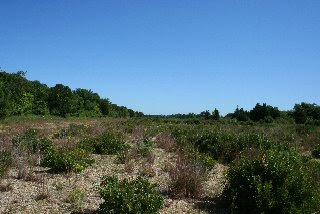This is a summary of data from 8 fields from the Rhode Island NWR Complex during late August 2008.
A complete table of the data is available from Leo Shapiro (lshapiro@umd.edu), Sam Droege (sdroege@usgs.gov), or the refuge biologist.
Below is a table of the site numbers and the brief site description.
| Site | Description |
| 5558 | RINWRC Site 1;Ninigret NWR |
| 5559 | RINWRC Site 2;Ninigret NWR |
| 5560 | RINWRC Site 3;Ninigret NWR |
| 5561 | RINWRC Site 4;Ninigret NWR |
| 5562 | RINWRC Site 5;Trustom Pond NWR |
| 5563 | RINWRC Site 6;Trustom Pond NWR |
| 5564 | RINWRC Site 7;Trustom Pond NWR |
| 5565 | RINWRC Site 8;Trustom Pond NWR |
Below is a table of the results by site:
Interpretation of the results: Excellent number of bees and diversity in these fields! 30 species, 241 specimens, which comes to about 2 bees on average per bowl. First let's note a set of new state records for Rhode Island based on the list maintained by John Ascher at the American Museum: Augochloropsis metallica, Lasioglossum anomalum, Anthidium manicatum, Megachile montivaga, and Coelioxys sayi. Now before the refuge's head gets too swollen, the list of bees for the Rhode Island is low and all these species have been found in neighboring states, but on the other hand it shows the type of contribution that can be made in light of a general lack of understanding of bees....so good work!

Anthidium manicatum is an interesting new arrival to the U.S. Here's the current distribution (and a few West Coast records that are not shown). Moving north and west it will likely soon cover the region. It is particularly fond of nice gardens that have Stachys, which it uses to line its nests.


Lasioglossum ellisiae would have been called L. tegulare in the recent past, but there is a paper in review that splits these two apart. The Lasioglossum sp. are all males that at this point I can't identify to species. There are an interesting number of nest parasites in this group of bees (these are bees that lay their eggs in the nests of other bee species rather than providing for their young themselves). The 3 Sphecodes are parasites of Lasioglossum species and the Coelioxys sayi is a parasite of Megachile bees.
Ninigret fields have many more H. ligatus, L. ellisiae, and L. pilosum than Trustom pond, which is more characterized by higher numbers of Agapostemon virescens and Hylaeus. Based on the species list it looks like the Ninigret fields are more open and potentially sandy, but they don't have any of the species that are characteristic of deep sand. The species diversity at Ninigret is much lower at 15 species to Trustom's 26. Again, a nice set of bees for this refuge complex.
Sam and Leo
Bee Song
Bees in the late summer sun
Drone their song
Of yellow moons
Trimming black velvet
Droning, droning a sleepysong.
- Carl SandburgSite 5565









No comments:
Post a Comment